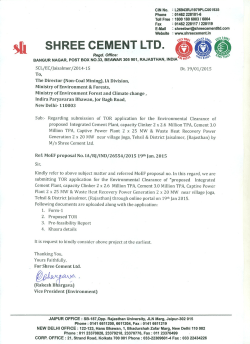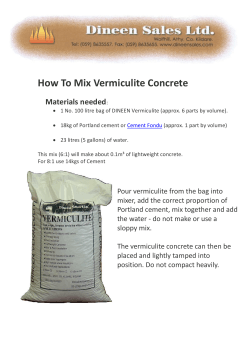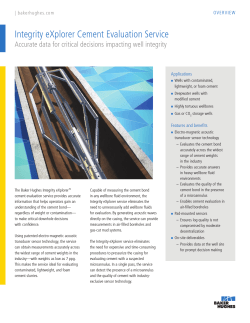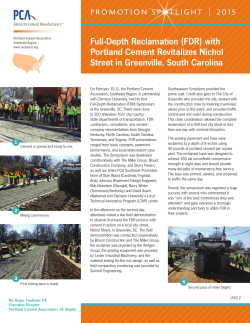
Detection of limestone zones using Image processing Techniques
Ministry of Minerals Geological Researches Authority of Sudan By: Roaa A.Azeem Projects planning Dep., The Geological Researches Authority of Sudan, Sudan Out lines •Introduction •Study area •Objective •Methodology •Lithology investigation •Processing Techniques •Result •Conclusion SUDAN General: Area: 1.882.000 square kilometers Population: 33,419,000 persons It is neighbored by sevencountries Economy The back bone of Sudan economy is Minerals, Agriculture supported by huge animals wealth. Cement production have also begun to be important to the Sudanese economy. •Introduction Limestone is one of the most important economic industrial materials in cement manufacturing and other industries. Objective The main objective of this paper is to give an idea of the applications of the remote sensing technology in detection of limestone. The challenge is to find way for identify limestone in a regional scale. SAVE..time, money. Improving and updating of geological mapping. Increasing of the national income. Study area Atbara area is located in the River Nile State of the Sudan APPLICATION Kadabas TEST Atbara Marble Quarry Atbara •Methodology 1- Remotely sensed data (ETM+, TM) 2- Lithology Investigation 3- using of principal component and bands combination for investigating limestone Using software ENVI4.5 (The Environment for Visualizing Images) 1. PCA principal Component Analysis 2. Choosing uncorrelated data Lithology Investigation GEOLOGY Marble in this area belongs to the meta-sedimentary part of Kurmut Series. Kurmut Series consists of meta-sediments such as marbles, calc-silicate rocks, quartzites, paragneisses, mica schists and graphitic schist with intercalations of metavolcanic rocks and basic dykes. The marble bands are well foliated and folded with fold axes plunging in different directions with N and NE axial planes Processing Techniques 1. PCA principal Component Analysis Row data PC data Uncorrelated, Wide range Highly Correlated, narrow range Using software ENVI4.5 (The Environment for Visualizing Images) Our methodology is based on the Principal Component Analysis (PCA) PCA is used to convert raw remote sensing data of multi-spectral imageries into a new principal component image, which is more easily interpretable. PCA is a statistical technique widely used in RS to choose the suitable bands and to show spectral differences which helps to display clearly the correlation of the spectral values between the different channels. Processing Techniques 2. Choosing uncorrelated data • PC analysis shows spectral differences which helps to display clearly the correlation of the spectral values between the different channels. • After Principal Component transformation, visual inspection of the PC color composites indicates that the composite containing the PC1,PC2, PC3, PC4 were the most informative mainly for the limestone formation. Processing Techniques 3. Bands combination 1 1. Color Composite of bands 7,4,1 in (RGB) express more geological information and provide higher contrast between units than the conventional color Images Fig.1. 2. PC A ratio of PC1,PC2,PC3,PC4 gives sharp spectral response of the limestone, so the combination of PC2/PC4/PC1 for TM image Fig.2 and PC4/PC3/PC2 for ETM+ Fig.1 gives a very distinctive results. 2 3 PC2 PC3 1- PC2, PC4 and PC1 indicating high and good contrast for limestone (TM). PC4 PC4/3/2 2- PC4, PC3 and PC2 Best bands combination of ETM+ in RGB 3- Accurate map Has been established 1. Sudan had seven cement plants with a combined capacity of 10.1 million metric tons per year (Mt/yr). 2. National cement production increased to nearly 3.48 Mt in 2012 from 3 Mt in 2011 and 246,500 metric tons (t) in 2008. Output increased because of the expansion of Al-Rajhi Group’s Atbara plant and the opening of six new plants from 2008 to 2011 (International Cement Review, 2011; Bank of Sudan, 2013a, p. 142). 3. New plants • Al-Rajhi Group produced about 1.12 Mt of cement • ASEC Cement Co. of Egypt (690,800 t.) • Berber Cement Co., 605,700 t. • Al-Shamal Cement Factory, 551,600 t. • Al-Salam Cement Production Company Ltd. 288,300 t • Nile Cement Company Ltd., 149,100 t. • Aslan Cement Co., 68,700 t. The increase in production was broadly based in 2012, with output increasing at all plants except for ASEC and Aslan (Bank of Sudan, 2013a, p. 142). Remote Sensing techniques are an efficient tool for geological mapping. This study showed that the Principal Component analysis processing technique is more efficient in discrimination and delineation of limestone units and their regional extension. The data obtained by this study were applied for the extension of Atbara cement factory and will be very useful forfuture new cement manufacturing. Strongly recommended, as indicated by this study, to integrate processed remotely sensed data and available geologic information to locate and determine the limestone rocks in other areas of similar conditions.
© Copyright 2025













